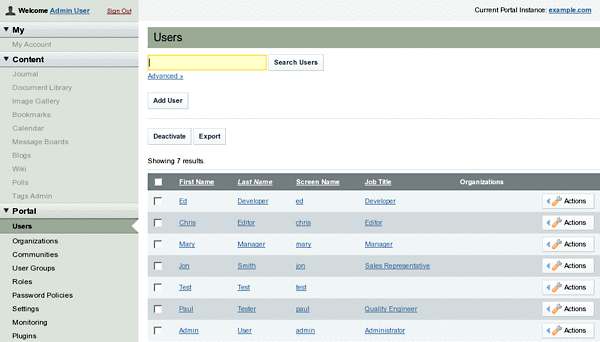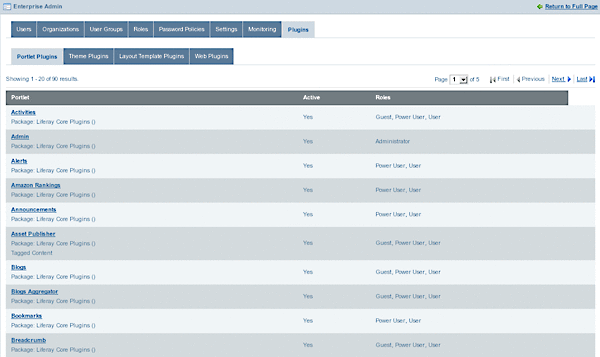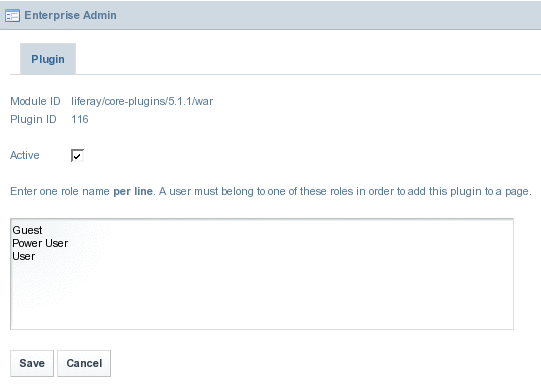Chapter 4 Administering Roles and Permissions
Roles and permissions can be administered by using portlets such as the Enterprise Admin Portlet and Communities Portlet. Alternatively, you can use the Control Panel to administer roles and permissions. The admin user needs to administer roles and permissions for the resources he need to manage to build a site.
Portlets for Administering Roles and Permissions
The admin user can use the Control Panel to set roles and permissions for users, user groups, communities, and organizations. Also, the Enterprise Admin portlet and Communities are the most helpful in administering roles and permissions.
Using the Control Panel to Administer Roles and Permissions
The admin user can use the Control Panel to administer roles and permissions.
 To use the Control Panel to Administer Roles and Permissions
To use the Control Panel to Administer Roles and Permissions
-
Login to Project WebSynergy as Admin user.
-
Choose Control Panel from the welcome menu.
Figure 4–1 Choosing Control Panel from the welcome menu

The Control Panel page appears.
Figure 4–2 The Control Panel

-
To view and make changes to an item, choose an item from the left menu.
For example, click Users under Portal. From this page, you can set roles and permissions for users. Similarly, you can set roles and permissions for Organizations, Communities, and User Groups.
Figure 4–3 Using the Control Panel

Using Administrative Portlets of WebSynergy
The Enterprise Admin portlet is used for most administrative tasks. This portlet has an interface for the creation and maintenance of the following:
-
Users
-
Organizations
-
User Groups
-
Roles
Additionally, it allows you to configure many server settings, including:
-
Information about the site
-
Authentication options, including Single Sign-On and LDAP integration
-
Default User Associations
-
Reserved Screen Names
-
Mail Host Names
-
Email Notifications
You need to use the Enterprise Admin portlet to create your portal structure, implement security, and administer users. Only the users with the Administrator role has permission to add the Enterprise Admin portlet to a page.
WebSynergy Portal Resources
The following is a brief overview of concepts which WebSynergy uses to organize a portal and to add and maintain user resources.
-
Portals are accessed by Users.
-
Users can be collected into User Groups.
-
Users can belong to Organizations.
-
Organizations can be grouped into hierarchies.
-
Users, Groups, and Organizations can belong to Communities that have a common interest.
The simplest way to think about this is that you have users and various ways those users can be grouped together. Some of these groupings follow an administratively organized hierarchy, and other groupings may be done by the users themselves (such as different users from multiple organizations starting a community called 'Dog Lovers' that has a common interest in dogs). And other groupings may be done administratively via User Groups or Roles for other functions that may cut across the portal (such as a Message Board Administrators group made up of users from multiple communities and organizations, allowing those users to administer any message board in the portal).
This way of organizing portal concepts may be illustrated in the following manner:
Figure 4–4 WebSynergy Portal Resources

In the illustration above, each arrow may be read using the words “can be a member of”. So this means that Organizations can be members of Communities, Communities can be members of Roles, Users can be members of anything, and so on. Though this seems very complex, it provides a powerful mechanism for portal administrators to configure portal resources and security in a consistent and robust manner.
User Groups
User Groups are arbitrary groupings of users. These groups are created by portal administrators to group users who do not have an obvious organizational or community-based attribute or aspect that brings them together. Groups can have permissions, much like roles. You would therefore use a User Group to grant permissions to any arbitrary list of users.
For example, a User Group called “People Who Have Access to My Stuff” could be created, and permission to a particular Document Library folder could be granted to that User Group. This list of users could be members of separate Organizations, Communities, or Roles, who happen to also have access to this 'Document Library' folder which is on some personal, community, or organization page that is accessible to them in the portal.
Defining User Groups
To be done.
 To Create a User Group
To Create a User Group
-
Login to WebSynergy as Admin user.
-
Click 'Add Applications' from the welcome menu.
Figure 4–5 Adding Enterprise Admin portlet to the portlet page

-
Click Add' against the 'Enterprise Admin' portlet.
-
Click on 'User Groups'.
-
Click 'Add'.
-
Specify a name and a description for the group and click Save.
Assigning Users to User Groups
To be done.
 To Assign Users to User Groups
To Assign Users to User Groups
-
Login to WebSynergy as Admin user.
-
Click 'Add Applications' from the welcome menu.
-
Click 'Add' against the 'Enterprise Admin' portlet.
-
Click on 'User Groups'.
-
Click 'Actions' button corresponding to a user group and select 'Assign Members' from the menu.
This page allows making assignments to the user group.
-
Choose the 'Available' tab to view the list of all available members.
-
Select the users who you are needed in the user group and click 'Update Associations'.
-
Choose the 'Current' tab to verify updated associations to the user group.
Communities
Communities are collections of Users who have a common interest. WebSynergy's default pages are in the 'Guest' community, because everyone-whether they are anonymous or members of the portal has common interest in the default public pages of your site.
There are three types of Communities:
-
Open
-
Restricted
-
Private
An Open Community (the default) allows portal users to join and leave the Community whenever they want to, provided they have access to a Communities portlet from which to do this. A Restricted Community requires that users be added to the Community by a community administrator. Users may use the 'Communities' portlet to request membership. A Private community do not allow users to join and to leave the community.
Defining Communities
To be done.
 To add a Community
To add a Community
-
Login to WebSynergy as Admin user.
-
Click 'Add Applications' from the welcome menu.
-
Click 'Add' against the 'Communities' portlet.
-
Click 'Add Community'.
-
Specify the Name, Description, Type, and Active attributes for the community. Open is the default type.
-
Click Save to save the community.
Assigning Users to Communities
To be done.
 To Assign Users to a Community
To Assign Users to a Community
-
Login to WebSynergy as Admin user.
-
Click 'Add Applications' from the welcome menu.
-
Click 'Add' against the 'Communities' portlet.
-
Click 'Available Communities' to list all available communities.
-
Click the 'Actions' button for the community, and select 'Assign Members' from the menu.
All the current Users, Organizations, and User Groups are listed in their respective tabs.
-
Click 'Available' tab under 'Users' tab to list all available users.
-
Select the checkbox against each of the users who you want to assign as members.
-
Click 'Update Associations' button to assign selected users as members.
-
Click 'Current' tab to view the current members which includes the new members assigned to the community.
Organizations
Organizations are hierarchical collections of Users. They are one of the two types of portal resources that can have pages. There is also a special type of Organization called 'Location', which can define where users are specifically located.
There are two kinds of Organizations:
-
Regular
-
Location
The organization of type Regular can have suborganizations, but an organization of type Location is not allowed to have suborganizations.
Let us consider the example of creating an organization called Admin Organization and a Suborganization called Admin Location.
Defining Organizations
This section outlines the procedure for Create an Organizationand Creating a Suborganization.
 To Create an Organization
To Create an Organization
-
Login to WebSynergy as Admin user.
-
Click 'Add Applications' from the welcome menu.
-
Click 'Add' against the 'Enterprise Admin' portlet.
-
Click 'Organizations'.
All the existing organizations are listed.
-
Click 'Add' to add a new organization.
-
Specify the 'Name' and 'Type' for the organization. For an organization of type 'Location', also specify the 'Country' and 'Region'.
-
Click Save.
You can specify the other attributes such as, address, phone number, email ID, and website.
-
Click 'Return to Full Page' to navigate back.
-
Click the 'Organizations' tab.
You will find the just created organization in the list of all organizations.
 To Create a Suborganization
To Create a Suborganization
-
Login to WebSynergy as Admin user.
-
Click 'Add Applications' from the welcome menu.
-
Click 'Add' against the 'Enterprise Admin' portlet.
-
Click 'Organizations'.
All the existing organizations are listed.
-
Click 'Add' to add a new organization.
-
Specify the 'Name' and 'Type' for the organization. For an organization of type 'Location', also specify the 'Country' and 'Region'.
-
Click 'Select' to select a parent organization.
The resultant window lists all the Organizations of type Regular.
Note –The system restricts creating a Location Organization without assigning a parent organization to it.
-
Select an organization to make it the parent organization.
The organization being created becomes the suborganization of the parent organization.
-
Click Save.
Note –An alternative method for selecting a parent organization for an organization is by selecting Add Regular Organization or Add Location from the menu appearing on clicking the Actions button corresponding to an organization. If you want to select a Regular Organization as the parent organization, select Add Regular Organization from the menu. If you want to select an organization of type Location as the parent organization, select Add Location from the menu.
Creating Users Under an Organizations
To be done.
 To Create Users under an Organization
To Create Users under an Organization
-
Login to WebSynergy as Admin user.
-
Click 'Add Applications' from the welcome menu.
-
Click 'Add' against the 'Enterprise Admin' portlet.
-
Click 'Organizations'.
All the existing organizations are listed.
-
Click 'Actions' button corresponding to an organization.
-
Select 'Add User' from the menu.
Specify the name and other details for the user. By default, the user is assigned to the same organization. To change the organization for the user, or to assign the user to more organizations, click the Organizations link under User Information.
Figure 4–6 Selecting an organization

-
Click Save.
The user is created.
-
Update the User Information, Identification, and other details of the organization.
-
Click Save.
Users and User Roles
There are three kinds of User Roles:
-
Regular
-
Organization
-
Community
What Different User Roles Mean?
A user generally has some Regular, Organization, and Community roles. You can view the roles and other attributes associated with a user by selecting a user from the User tab in the Enterprise Admin portlet.
Regular Roles
Guest, User, Power User, Owner, and Administrator are the different Regular Roles. All the user with login access to WebSynergy are assigned with the 'User' role. It defines the difference between a Guest and a person who has a user ID in the portal. By default, all users are also assigned the Power User role. This role by default gives users their own personal pages (both public and private) where they can place portlets.
To make yourself an Administrator, click the Select link. A window listing all the roles in the system pops us. Click the Administrator link from the pop-up window. You are now an administrator of the portal. Log out of the portal and then log back in with your own user ID. You can now create a private page for the administration portlets and set them up in your own space.
Organization Roles
You can assign organization roles to users who are members of a organization. Organization Administrator, Organization Member, and Organization Owner are the roles which can be assigned to a user.
Community Roles
You can assign community roles to users who are members of a community. Community Administrator, Community Member, Community Owner, Content Designer, Content Editor, and Content Publisher are the roles which can be assigned to a user.
Defining User Roles
All users are listed on clicking the Users tab in the Enterprise Admin portlet. You can assign roles to a user.
 To Define User Roles
To Define User Roles
-
Login to WebSynergy as Admin user.
-
Click 'Add Applications' from the welcome menu.
-
Click 'Add' against the 'Enterprise Admin' portlet.
-
Click the “Users' tab.
-
Choose a user from the list.
You can define Regular Roles, Community Roles, and Organization Roles tabs allow assigning Regular, Community, and Organization roles for the user.
-
Click 'Roles' under 'User Information' for the user.
You can assign Regular roles for all users in addition to the default Regular roles. To assign Organization or Community roles, the user need to be a member of a WebSynergy organization or community. Also you can remove the roles assigned to a user.
-
Click Save.
Plugins
To be done.
What Are Plugins?
To be done.
Enabling Plugins
To be done.
 To Access Plugins
To Access Plugins
-
Login to WebSynergy as Admin user.
-
Click 'Add Applications' from the welcome menu.
-
Click 'Add' against the 'Enterprise Admin' portlet.
-
Expand the Enterprise Admin portlet to view all the tabs associated with the portlet.
-
Choose the 'Plugins' tab.
Figure 4–7 Plugins tab of the Enterprise Admin portlet

You can see four tabs listing portlets of four different categories namely; Portlet Plugins, Theme Plugins, Layout Template Plugins, Web Plugins.
Working With Plugin Permissions
You can activate or deactivate a Portlet Plugin, and you can change the User Roles associated with a plugin. For example, the Admin portlet has the Administrator role associated with it. This means, a user registered as an administrator can access the portlet.
 To Change Plugin Permissions
To Change Plugin Permissions
-
Login to WebSynergy as Admin user.
-
Click 'Add Applications' from the welcome menu.
-
Click 'Add' against the 'Enterprise Admin' portlet.
-
Expand the Enterprise Admin portlet to view all the tabs associated with the portlet.
-
Choose the 'Plugins' tab.
-
Click the link for a portlet.
For example, click on the Activities portlet.
Figure 4–8 Changing the plugin permissions

-
Click Save.
- © 2010, Oracle Corporation and/or its affiliates
